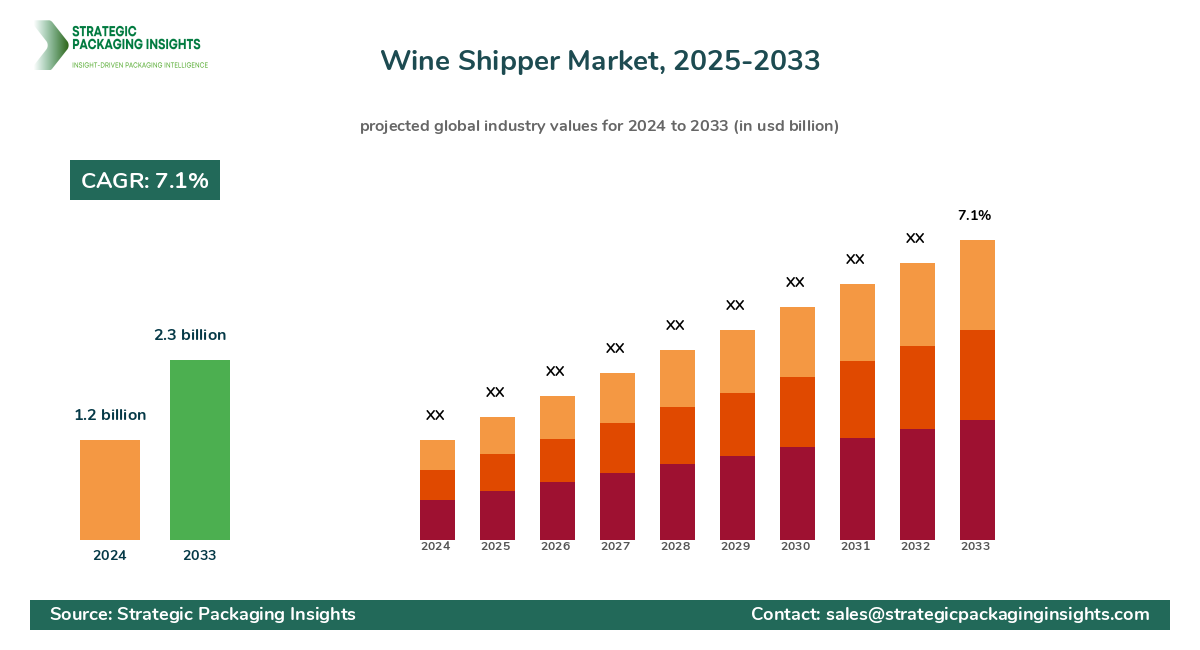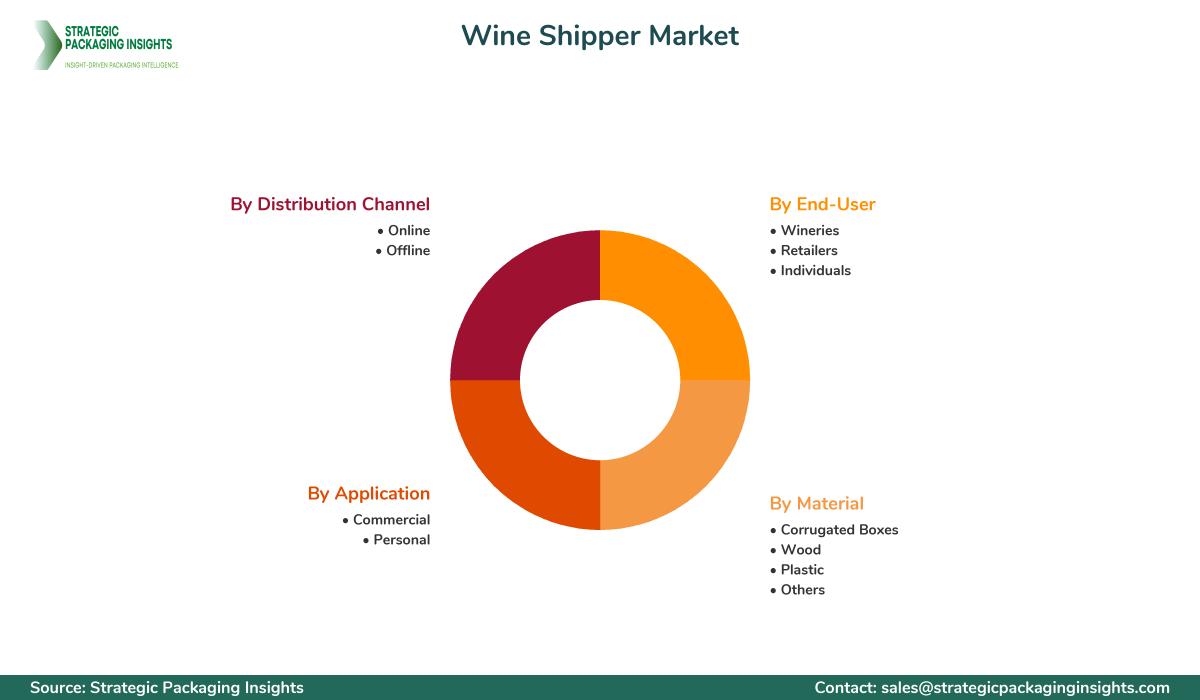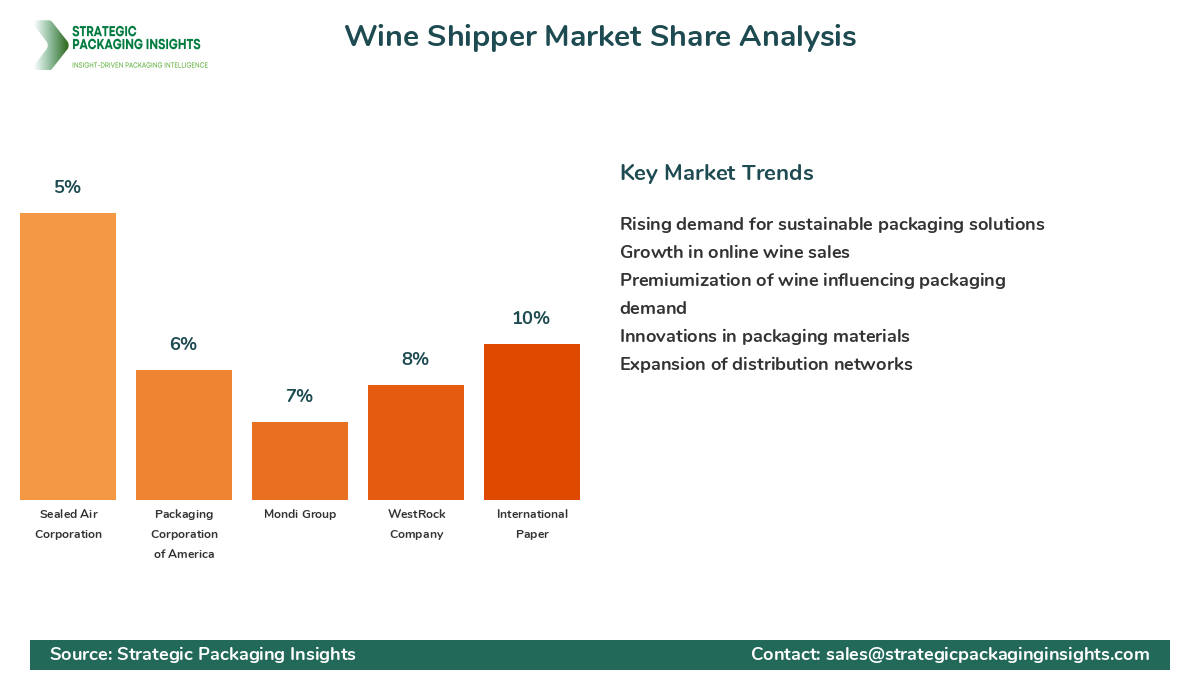- Home
- Beverage Packaging
- Wine Shipper Market Size, Future Growth and Forecast 2033
Wine Shipper Market Size, Future Growth and Forecast 2033
Wine Shipper Market Segments - by Material (Corrugated Boxes, Wood, Plastic, Others), Application (Commercial, Personal), Distribution Channel (Online, Offline), End-User (Wineries, Retailers, Individuals) - Market Dynamics, Growth Opportunities, Strategic Drivers, and PESTLE Outlook (2025–2033)
Wine Shipper Market Outlook
The wine shipper market was valued at $1.2 billion in 2024 and is projected to reach $2.3 billion by 2033, growing at a CAGR of 7.1% during the forecast period 2025-2033. This market is driven by the increasing global demand for wine, coupled with the rise in e-commerce platforms facilitating wine sales. The growth in wine consumption, particularly in emerging markets, has necessitated the development of efficient and secure shipping solutions. Wine shippers, designed to protect bottles during transit, are becoming increasingly sophisticated, incorporating advanced materials and designs to ensure product safety and quality. The market is also witnessing innovations in sustainable packaging solutions, as environmental concerns drive demand for eco-friendly shipping options.
Report Scope
| Attributes | Details |
| Report Title | Wine Shipper Market Size, Future Growth and Forecast 2033 |
| Base Year | 2024 |
| Historic Data | 2017-2023 |
| Forecast Period | 2025-2033 |
| Number of Pages | 240 |
| Material | Corrugated Boxes, Wood, Plastic, Others |
| Application | Commercial, Personal |
| Distribution Channel | Online, Offline |
| End-User | Wineries, Retailers, Individuals |
| Customization Available | Yes* |
Opportunities & Threats
One of the significant opportunities in the wine shipper market is the growing trend of online wine sales. As consumers increasingly turn to digital platforms for purchasing wine, the demand for reliable and secure shipping solutions is on the rise. This shift is particularly pronounced in regions with high internet penetration and a burgeoning middle class, such as Asia Pacific and Latin America. Additionally, the premiumization of wine, where consumers are willing to pay more for high-quality products, is driving the need for premium packaging solutions that not only protect but also enhance the perceived value of the wine.
Another opportunity lies in the development of sustainable packaging solutions. With increasing awareness of environmental issues, consumers and companies alike are seeking eco-friendly alternatives to traditional packaging materials. This has led to innovations in biodegradable and recyclable materials, offering companies a chance to differentiate themselves in the market. Furthermore, regulatory pressures in regions like Europe, which are pushing for reduced carbon footprints, are encouraging the adoption of sustainable practices in the wine shipping industry.
However, the market faces several threats, including the volatility of raw material prices. The cost of materials such as corrugated cardboard and plastics can fluctuate significantly, impacting the profitability of wine shipper manufacturers. Additionally, stringent regulations regarding packaging materials, particularly in terms of environmental compliance, can pose challenges for companies operating in this space. The need to constantly innovate and adapt to changing regulations can strain resources, particularly for smaller players in the market.
The wine shipper market is characterized by a competitive landscape with several key players vying for market share. Companies are focusing on product innovation, strategic partnerships, and mergers and acquisitions to strengthen their market position. The competitive dynamics are influenced by factors such as product quality, pricing strategies, and distribution networks. Leading companies in the market are investing heavily in research and development to introduce innovative packaging solutions that cater to the evolving needs of consumers and businesses.
Smurfit Kappa, a prominent player in the market, holds a significant share due to its extensive product portfolio and strong distribution network. The company is known for its innovative packaging solutions that prioritize sustainability and efficiency. Similarly, DS Smith has carved a niche for itself with its focus on eco-friendly packaging solutions, catering to the growing demand for sustainable options in the market.
Another major player, International Paper, leverages its global presence and extensive manufacturing capabilities to maintain a competitive edge. The company's commitment to sustainability and innovation has helped it secure a substantial market share. Meanwhile, WestRock Company is recognized for its comprehensive range of packaging solutions and its strategic focus on mergers and acquisitions to expand its market reach.
Other notable companies in the market include Mondi Group, which emphasizes sustainable packaging solutions, and Packaging Corporation of America, known for its high-quality corrugated packaging products. These companies, along with others like Sealed Air Corporation and Amcor, are actively engaged in enhancing their product offerings and expanding their geographical footprint to capture a larger share of the market.
Key Highlights Wine Shipper Market

- Increasing demand for sustainable and eco-friendly packaging solutions.
- Growth in online wine sales driving demand for secure shipping solutions.
- Rising wine consumption in emerging markets boosting market growth.
- Innovations in packaging materials enhancing product safety and quality.
- Regulatory pressures encouraging sustainable practices in packaging.
- Strategic partnerships and acquisitions shaping competitive dynamics.
- Premiumization of wine influencing demand for high-quality packaging.
- Volatility in raw material prices impacting profitability.
- Focus on research and development driving product innovation.
- Expansion of distribution networks enhancing market reach.
Premium Insights - Key Investment Analysis
The wine shipper market is witnessing significant investment activity, driven by the growing demand for innovative and sustainable packaging solutions. Venture capital firms and private equity investors are increasingly focusing on companies that offer eco-friendly and technologically advanced packaging options. The trend towards sustainability is a major investment theme, with investors seeking to capitalize on the shift towards biodegradable and recyclable materials.
Merger and acquisition activity is also prominent in the market, as companies look to expand their product portfolios and geographical presence. Strategic acquisitions are being pursued to gain access to new technologies and enhance competitive positioning. The market is also seeing investments in research and development, aimed at developing new materials and designs that improve the safety and efficiency of wine shipping.
Investment valuations in the wine shipper market are being driven by the potential for high returns, as the demand for premium and sustainable packaging solutions continues to grow. Investors are particularly interested in companies that demonstrate strong innovation capabilities and have a clear strategy for addressing environmental concerns. The market's growth potential, coupled with the increasing importance of sustainability, makes it an attractive investment opportunity for both institutional and individual investors.
Wine Shipper Market Segments Insights

Material Analysis
The material segment of the wine shipper market is dominated by corrugated boxes, which are favored for their durability and cost-effectiveness. Corrugated boxes offer excellent protection for wine bottles during transit, making them a popular choice among wineries and retailers. The demand for corrugated boxes is further driven by their recyclability, aligning with the growing trend towards sustainable packaging solutions. However, the market is also witnessing a rise in the use of alternative materials such as wood and plastic, which offer unique benefits in terms of aesthetics and strength.
Wooden wine shippers are gaining traction, particularly in the premium segment, where the emphasis is on enhancing the perceived value of the wine. These shippers are often used for gifting purposes and are valued for their aesthetic appeal and robustness. On the other hand, plastic wine shippers are appreciated for their lightweight nature and resistance to moisture, making them suitable for long-distance shipping. The choice of material is often influenced by factors such as cost, environmental impact, and the specific requirements of the end-user.
Application Analysis
The application segment of the wine shipper market is broadly categorized into commercial and personal use. Commercial applications dominate the market, driven by the extensive use of wine shippers by wineries, retailers, and distributors. These entities require reliable and efficient packaging solutions to ensure the safe delivery of wine to consumers and businesses. The rise in online wine sales has further fueled the demand for commercial wine shippers, as companies seek to enhance their logistics capabilities to meet consumer expectations.
Personal applications, while smaller in scale, represent a growing segment of the market. Individuals purchasing wine for personal consumption or gifting purposes are increasingly seeking high-quality packaging solutions that offer both protection and aesthetic appeal. The trend towards personalized and customized packaging is gaining momentum, with consumers willing to pay a premium for unique and visually appealing wine shippers. This segment is expected to witness steady growth, driven by the increasing popularity of wine as a gift and the rise in direct-to-consumer sales channels.
Distribution Channel Analysis
The distribution channel segment of the wine shipper market is divided into online and offline channels. Offline channels, including specialty stores and supermarkets, have traditionally dominated the market, offering consumers the opportunity to physically inspect and purchase wine shippers. However, the rapid growth of e-commerce platforms is reshaping the distribution landscape, with online channels gaining significant traction.
Online distribution channels offer several advantages, including convenience, a wider selection of products, and competitive pricing. The increasing penetration of the internet and the growing preference for online shopping are driving the shift towards digital platforms. Companies are investing in enhancing their online presence and optimizing their supply chains to cater to the rising demand for online wine shipper purchases. This trend is expected to continue, with online channels playing an increasingly important role in the distribution of wine shippers.
End-User Analysis
The end-user segment of the wine shipper market is comprised of wineries, retailers, and individuals. Wineries represent the largest end-user segment, as they require robust and reliable packaging solutions to transport their products to distributors and consumers. The need for efficient logistics and the emphasis on product safety are key drivers of demand in this segment. Retailers, including both brick-and-mortar stores and online platforms, also constitute a significant portion of the market, as they seek to offer a diverse range of packaging options to their customers.
Individuals, while representing a smaller segment, are increasingly contributing to market growth. The rise in direct-to-consumer sales and the growing popularity of wine as a gift are driving demand for high-quality and aesthetically pleasing wine shippers. The trend towards personalized and customized packaging solutions is particularly pronounced among individual consumers, who are willing to invest in unique and visually appealing products. This segment is expected to witness steady growth, supported by the increasing accessibility of wine and the expansion of online sales channels.
Market Share Analysis
The market share distribution of key players in the wine shipper market is influenced by several factors, including product innovation, pricing strategies, and distribution networks. Leading companies such as Smurfit Kappa, DS Smith, and International Paper hold significant market shares due to their extensive product portfolios and strong global presence. These companies are known for their commitment to sustainability and innovation, which has helped them maintain a competitive edge in the market.
Smurfit Kappa, for instance, is recognized for its innovative packaging solutions that prioritize sustainability and efficiency. The company's focus on research and development has enabled it to introduce new products that cater to the evolving needs of consumers and businesses. Similarly, DS Smith has carved a niche for itself with its emphasis on eco-friendly packaging solutions, catering to the growing demand for sustainable options in the market.
International Paper leverages its global presence and extensive manufacturing capabilities to maintain a competitive edge. The company's commitment to sustainability and innovation has helped it secure a substantial market share. Meanwhile, WestRock Company is recognized for its comprehensive range of packaging solutions and its strategic focus on mergers and acquisitions to expand its market reach.
Top Countries Insights in Wine Shipper
The United States is a leading market for wine shippers, with a market size of approximately $400 million and a CAGR of 6%. The country's robust wine industry, coupled with the growing trend of online wine sales, is driving demand for efficient and secure shipping solutions. Regulatory support for sustainable packaging practices is also encouraging the adoption of eco-friendly wine shippers.
In Europe, France is a key market, with a market size of $300 million and a CAGR of 5%. The country's rich wine heritage and strong export market are fueling demand for high-quality packaging solutions. The emphasis on sustainability and the stringent regulatory environment are driving innovations in eco-friendly packaging materials.
China is emerging as a significant market for wine shippers, with a market size of $250 million and a CAGR of 8%. The country's growing middle class and increasing wine consumption are driving demand for premium packaging solutions. The rise in e-commerce platforms is further boosting the market, as consumers increasingly turn to online channels for purchasing wine.
Australia, with a market size of $150 million and a CAGR of 7%, is witnessing growth in the wine shipper market due to its strong wine export industry. The country's focus on sustainability and innovation is driving demand for eco-friendly packaging solutions. The expansion of online sales channels is also contributing to market growth.
In Latin America, Brazil is a key market, with a market size of $100 million and a CAGR of 6%. The country's growing wine industry and increasing consumer awareness of sustainable packaging options are driving demand for wine shippers. The rise in online wine sales is also contributing to market growth, as consumers seek convenient and reliable shipping solutions.
Wine Shipper Market Segments
The Wine Shipper market has been segmented on the basis of
Material
- Corrugated Boxes
- Wood
- Plastic
- Others
Application
- Commercial
- Personal
Distribution Channel
- Online
- Offline
End-User
- Wineries
- Retailers
- Individuals
Primary Interview Insights
What are the key drivers of growth in the wine shipper market?
How is the trend towards sustainability impacting the wine shipper market?
What challenges do companies face in the wine shipper market?
How are companies responding to the growth in online wine sales?
What role does innovation play in the wine shipper market?
Latest Reports

The Hot Melt Glue Labeler market was valued at $1.2 billion in 2024 and is projected to reach $2.3 billion by 2033, growing at a CAGR of 6.5% during the forecast period 2025–2033.

The Ethical Label market was valued at $1.5 billion in 2024 and is projected to reach $3.2 billion by 2033, growing at a CAGR of 8.5% during the forecast period 2025–2033.

The Packaging Tensioner market was valued at $1.2 billion in 2024 and is projected to reach $2.3 billion by 2033, growing at a CAGR of 6.5% during the forecast period 2025–2033.

The foodservice packaging market was valued at $120 billion in 2024 and is projected to reach $180 billion by 2033, growing at a CAGR of 4.5% during the forecast period 2025–2033.

The nano-enabled packaging market was valued at $15.2 billion in 2024 and is projected to reach $35.6 billion by 2033, growing at a CAGR of 9.5% during the forecast period 2025–2033.

The Cold Seal Packaging market was valued at $1.5 billion in 2024 and is projected to reach $2.3 billion by 2033, growing at a CAGR of 4.8% during the forecast period 2025–2033.

The Transparent Barrier Packaging Films market was valued at $12.5 billion in 2024 and is projected to reach $20.3 billion by 2033, growing at a CAGR of 5.8% during the forecast period 2025–2033.

The Flatback Tape market was valued at $2.5 billion in 2024 and is projected to reach $4.1 billion by 2033, growing at a CAGR of 5.8% during the forecast period 2025–2033.

The packer bottle market was valued at $3.5 billion in 2024 and is projected to reach $5.8 billion by 2033, growing at a CAGR of 5.2% during the forecast period 2025–2033.

The Canada Nano-Enabled Packaging Food Beverages market was valued at $1.2 billion in 2024 and is projected to reach $3.5 billion by 2033, growing at a CAGR of 12.5% during the forecast period 2025–2033.

The India Aluminum Beverage Can market was valued at $1.2 billion in 2024 and is projected to reach $2.5 billion by 2033, growing at a CAGR of 8.5% during the forecast period 2025–2033.

The fast-food reusable packaging market was valued at $1.2 billion in 2024 and is projected to reach $3.5 billion by 2033, growing at a CAGR of 12.5% during the forecast period 2025–2033.

The pallets market was valued at $59.91 billion in 2024 and is projected to reach $88.69 billion by 2033, growing at a CAGR of 4.5% during the forecast period 2025–2033.

The lamination adhesives market was valued at $2.5 billion in 2024 and is projected to reach $4.1 billion by 2033, growing at a CAGR of 5.8% during the forecast period 2025–2033.

The garment packing machine market was valued at $1.2 billion in 2024 and is projected to reach $2.5 billion by 2033, growing at a CAGR of 8.5% during the forecast period 2025–2033.

The shrink bags market was valued at $3.5 billion in 2024 and is projected to reach $5.8 billion by 2033, growing at a CAGR of 5.2% during the forecast period 2025–2033.

The beverage packaging market was valued at $128 billion in 2024 and is projected to reach $186 billion by 2033, growing at a CAGR of 4.2% during the forecast period 2025–2033.

The North America Freight and Logistics market was valued at $1,200 billion in 2024 and is projected to reach $1,800 billion by 2033, growing at a CAGR of 4.5% during the forecast period 2025–2033.

The Anti-Counterfeiting Packaging market was valued at $105 billion in 2024 and is projected to reach $182 billion by 2033, growing at a CAGR of 6.5% during the forecast period 2025–2033.

The Active and Modified Atmospheric Packaging market was valued at $15.2 billion in 2024 and is projected to reach $25.8 billion by 2033, growing at a CAGR of 6.5% during the forecast period 2025–2033.

The molded fiber packaging market was valued at $7.5 billion in 2024 and is projected to reach $12.3 billion by 2033, growing at a CAGR of 5.8% during the forecast period 2025–2033.

The micro packaging market was valued at $1.2 billion in 2024 and is projected to reach $2.5 billion by 2033, growing at a CAGR of 8.5% during the forecast period 2025–2033.

The Anti-counterfeit Pharmaceuticals Packaging market was valued at $80 billion in 2024 and is projected to reach $150 billion by 2033, growing at a CAGR of 7.5% during the forecast period 2025–2033.

The MDO-PE Film market was valued at $3.5 billion in 2024 and is projected to reach $5.8 billion by 2033, growing at a CAGR of 5.2% during the forecast period 2025–2033.

The compostable pouch market was valued at $1.2 billion in 2024 and is projected to reach $3.5 billion by 2033, growing at a CAGR of 12.5% during the forecast period 2025–2033.

The Hot Melt Glue Labeler market was valued at $1.2 billion in 2024 and is projected to reach $2.3 billion by 2033, growing at a CAGR of 6.5% during the forecast period 2025–2033.

The Ethical Label market was valued at $1.5 billion in 2024 and is projected to reach $3.2 billion by 2033, growing at a CAGR of 8.5% during the forecast period 2025–2033.

The Packaging Tensioner market was valued at $1.2 billion in 2024 and is projected to reach $2.3 billion by 2033, growing at a CAGR of 6.5% during the forecast period 2025–2033.

The foodservice packaging market was valued at $120 billion in 2024 and is projected to reach $180 billion by 2033, growing at a CAGR of 4.5% during the forecast period 2025–2033.

The nano-enabled packaging market was valued at $15.2 billion in 2024 and is projected to reach $35.6 billion by 2033, growing at a CAGR of 9.5% during the forecast period 2025–2033.

The Cold Seal Packaging market was valued at $1.5 billion in 2024 and is projected to reach $2.3 billion by 2033, growing at a CAGR of 4.8% during the forecast period 2025–2033.

The Transparent Barrier Packaging Films market was valued at $12.5 billion in 2024 and is projected to reach $20.3 billion by 2033, growing at a CAGR of 5.8% during the forecast period 2025–2033.

The Flatback Tape market was valued at $2.5 billion in 2024 and is projected to reach $4.1 billion by 2033, growing at a CAGR of 5.8% during the forecast period 2025–2033.

The packer bottle market was valued at $3.5 billion in 2024 and is projected to reach $5.8 billion by 2033, growing at a CAGR of 5.2% during the forecast period 2025–2033.

The Canada Nano-Enabled Packaging Food Beverages market was valued at $1.2 billion in 2024 and is projected to reach $3.5 billion by 2033, growing at a CAGR of 12.5% during the forecast period 2025–2033.

The India Aluminum Beverage Can market was valued at $1.2 billion in 2024 and is projected to reach $2.5 billion by 2033, growing at a CAGR of 8.5% during the forecast period 2025–2033.

The fast-food reusable packaging market was valued at $1.2 billion in 2024 and is projected to reach $3.5 billion by 2033, growing at a CAGR of 12.5% during the forecast period 2025–2033.

The pallets market was valued at $59.91 billion in 2024 and is projected to reach $88.69 billion by 2033, growing at a CAGR of 4.5% during the forecast period 2025–2033.

The lamination adhesives market was valued at $2.5 billion in 2024 and is projected to reach $4.1 billion by 2033, growing at a CAGR of 5.8% during the forecast period 2025–2033.

The garment packing machine market was valued at $1.2 billion in 2024 and is projected to reach $2.5 billion by 2033, growing at a CAGR of 8.5% during the forecast period 2025–2033.

The shrink bags market was valued at $3.5 billion in 2024 and is projected to reach $5.8 billion by 2033, growing at a CAGR of 5.2% during the forecast period 2025–2033.

The beverage packaging market was valued at $128 billion in 2024 and is projected to reach $186 billion by 2033, growing at a CAGR of 4.2% during the forecast period 2025–2033.

The North America Freight and Logistics market was valued at $1,200 billion in 2024 and is projected to reach $1,800 billion by 2033, growing at a CAGR of 4.5% during the forecast period 2025–2033.

The Anti-Counterfeiting Packaging market was valued at $105 billion in 2024 and is projected to reach $182 billion by 2033, growing at a CAGR of 6.5% during the forecast period 2025–2033.

The Active and Modified Atmospheric Packaging market was valued at $15.2 billion in 2024 and is projected to reach $25.8 billion by 2033, growing at a CAGR of 6.5% during the forecast period 2025–2033.

The molded fiber packaging market was valued at $7.5 billion in 2024 and is projected to reach $12.3 billion by 2033, growing at a CAGR of 5.8% during the forecast period 2025–2033.

The micro packaging market was valued at $1.2 billion in 2024 and is projected to reach $2.5 billion by 2033, growing at a CAGR of 8.5% during the forecast period 2025–2033.

The Anti-counterfeit Pharmaceuticals Packaging market was valued at $80 billion in 2024 and is projected to reach $150 billion by 2033, growing at a CAGR of 7.5% during the forecast period 2025–2033.

The MDO-PE Film market was valued at $3.5 billion in 2024 and is projected to reach $5.8 billion by 2033, growing at a CAGR of 5.2% during the forecast period 2025–2033.

The compostable pouch market was valued at $1.2 billion in 2024 and is projected to reach $3.5 billion by 2033, growing at a CAGR of 12.5% during the forecast period 2025–2033.
